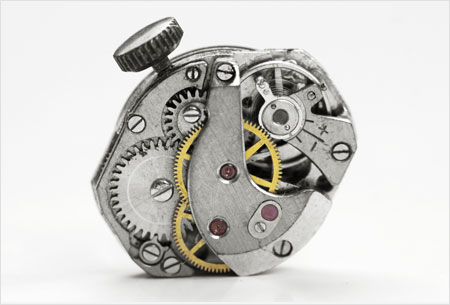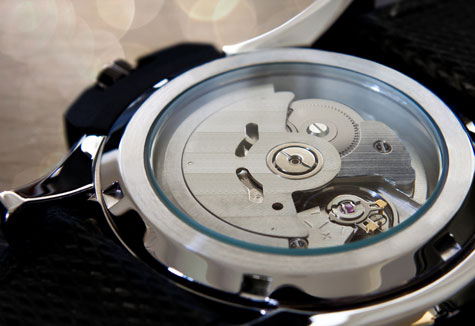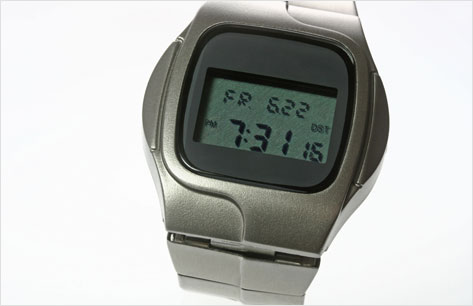Learn About Watches
Important Facts about Watches

Wristwatches became popular in the 1920s. Before then it was all about the pocket watch. Many had ornate covers and were tucked in vest pockets, usually secured with a chain or fob. Watches have a rich history that dates back to spring-powered clocks of the 15th century, steadily evolving into the personal-sized versions of the 17th and 18th centuries to the techno and trendy, fashionable and luxury timepieces we know and love today.
Movement
A movement in watch-making is the mechanism that measures the passage of time and displays the current time (and possibly other information including date, month and day). Movements may be entirely mechanical, entirely electronic (potentially with no moving parts), or a blend of the two. Most watches today that are intended mainly for timekeeping have electronic movements, with mechanical hands on the face of the watch indicating the time.
Mechanical movements
Compared to electronic movements, mechanical watches are less accurate, often with errors of seconds per day. They are also sensitive to position and temperature. Most are costly to produce, require regular maintenance and adjustment, and are more prone to failure. Nevertheless, the old world craftsmanship of mechanical watches still attracts interest from part of the watch-buying public.
Mechanical movements use an escapement mechanism to control and limit the unwinding and winding parts of a spring, converting what would otherwise be a simple unwinding into a controlled and periodic energy release. Mechanical movements also use a balance wheel together with the balance spring (also known as a hairspring) to control motion of the gear system of the watch. There is also the tourbillon, an optional part for mechanical movements. This is a rotating frame for the escapement, used to cancel out or reduce the effects of gravitational bias to the timekeeping. The tourbillon is a complex component and therefore quite expensive.
The pin-lever escapement is a less expensive version of the fully levered movement, and was manufactured in huge quantities by many Swiss manufacturers as well as Timex, until it was replaced by quartz movements.
Tuning-fork watches use a type of electromechanical movement. Introduced by Bulova in 1960, these watches used a tuning fork with a precise frequency to drive a mechanical watch. The task of converting an electronically-pulsed fork vibration into rotary movement is done via two tiny jeweled fingers, called pawls. Tuning-fork watches were rendered obsolete when electronic quartz watches were developed, because quartz watches were not only cheaper to produce but more accurate.
Electronic Movements
Electronic movements have few or no moving parts. They use the piezoelectric effect in a tiny quartz crystal to provide a stable time base for a mostly electronic movement. The crystal forms a quartz oscillator which resonates at a specific and highly stable frequency, providing for very accurate timekeeping. This is why electronic watches are often called quartz watches. Most quartz movements are primarily electronic and are geared to drive mechanical hands on the face of the watch providing a traditional analog display of the time.
Radio controlled watches or time signal watches are a type of electronic quartz watch which synchronizes its time with an external time source, from perhaps GPS navigation satellites. Movements of this type may synchronize not only the time of day but also the date, the leap-year status of the current year, and the current state of daylight saving time. Other than having a radio receiver, these watches are normal quartz watches in all other aspects.
Power Sources
Traditional mechanical watch movements use a spiral spring called a mainspring as a power source. In manual watches the spring must be rewound periodically by the user by turning the watch crown. Antique pocket-watches were wound by inserting a separate key into a hole in the back of the watch and turning it. Most modern watches are designed to run 40 hours on a winding and thus must be wound daily. Others run for several days and a few have 192-hour mainsprings and are wound weekly.
Important Facts about Watches

A self-winding or automatic watch is one that rewinds the mainspring of a mechanical movement by the natural motions of the wearer's body. The first self-winding mechanism was invented for pocket-watches in 1770 by Abraham-Louis Perrelet, but the first self-winding wristwatch was invented by British watch repairer John Harwood in 1923. This type of watch allows for constant winding without special action from the wearer. It uses an eccentric weight, called a winding rotor, which rotates with the movement of the wearer's wrist. The back-and-forth motion of the winding rotor couples to a ratchet to automatically wind the mainspring. Most self-winding watches can also be wound manually so they can be kept running when not worn or if the wearer's wrist motions are inadequate to keep the watch wound.
Some electronic watches are also powered by the movement of the wearer of the watch. For instance, Seiko's kinetic- powered quartz watches uses the everyday motions of a wearer's arm to turn a rotating weight which causes a tiny generator to supply power to charge a rechargeable battery that runs the watch. The concept is similar to that of self-winding spring movements, except that electrical power is generated instead of mechanical spring tension.
Electronic watches require electricity as a power source. Some mechanical movements and hybrid electronic-mechanical movements also require electricity. Usually the electricity is provided by a replaceable battery. The first electrically-powered watch, the Hamilton Electric 500, was released in 1957 by the Hamilton Watch Company of Lancaster, Pennsylvania.
Watch batteries are specially designed for their purpose. They are very small and provide tiny amounts of power continuously for very long periods which could mean several years or more. In most cases, replacing the battery requires a trip to a watch-repair shop or watch dealer. This is especially true for watches that are designed to be water-resistant, as special tools and procedures are required to ensure that the watch remains water-resistant after battery replacement. Silver-oxide and lithium batteries are popular today. Mercury batteries, formerly quite common, are no longer used for environmental reasons. Less expensive alkaline batteries are also available in the same size as the silver-oxide cells, but generally provide a shorter life. Rechargeable batteries are used in some solar powered watches.
Solar powered watches are powered by light. A photovoltaic cell on the face of the watch converts light to electricity which is used to keep the battery or capacitor charged. The movement of the watch draws its power from the rechargeable battery or capacitor. As long as the watch is regularly exposed to fairly strong light, it never needs battery replacement. Some models, like the Citizen Eco-Drive, need only a few minutes of sunlight to provide weeks of energy.
DISPLAYING TIME
Traditionally, watches have displayed the time in analog form, with a numbered dial with at least a rotating hour hand and a longer, rotating minute hand. Many watches also incorporate a third hand that shows the current second of the current minute. Watches powered by quartz usually have a second hand that snaps every second to the next marker. Watches powered by a mechanical movement have a sweep second hand, making an uninterrupted smooth or sweeping movement across the markers. This is actually a misnomer in most cases. The hand merely moves in smaller steps, typically 1/5th of a second, corresponding to the beat of the balance wheel. A truly sweeping second hand is achieved with the tri-synchro regulator of spring drive watches.
Analog display of the time is nearly universal in watches sold as jewelry or collectibles. In these timepieces, the range of different styles of hands, numbers, and other aspects of the analogue dial is very broad. Analog watches are specifically designed for the left wrist with the stem on the right side of the watch. If one is left-handed and wears the watch on the right wrist, one has to remove the watch from the wrist to reset the time or to wind the watch.
Important Facts about Watches

A digital display simply shows the time as a number instead of hands pointing at numbers around the dial.
The first digital electronic watch, a Pulsar LED prototype, was developed jointly by Hamilton Watch Company and Electro-Data in 1970. John Bergey, the head of Hamilton's Pulsar division, said that he was inspired to make a digital timepiece by the then-futuristic digital clock that Hamilton had made for the 1968 science fiction film 2001: A Space Odyssey. On April 4, 1972, the Pulsar was finally ready. It was made in 18-carat gold and sold for $2,100. It had a red LED display.
Digital LED watches were very expensive and out of reach to the common consumer until 1975, when Texas Instruments started to mass produce LED watches inside a plastic case. These watches retailed for $20, a far cry from the $2100. A few years later the price was down to $10, Pulsar lost millions and was sold to Seiko.
Most watches with LED displays required that the user press a button to see the time displayed for a few seconds, because LEDs used so much power that they could not be kept operating continuously. Watches with LED displays were popular for a few years, but soon the LED displays were superseded by LCDs, liquid crystal displays, which used less battery power and were much more convenient. LCDs constantly displayed the time without having to press a button.
Functions
All watches provide the time of day, giving at least the hour and minute, and usually the second. Most also provide the current date, and often the day of the week as well. However, many watches also provide a great deal of information beyond the basics of time and date. Some watches include alarms. Other elaborate and more expensive watches, both pocket and wrist models, also incorporate striking mechanisms or repeater functions, so that the wearer could learn the time by the sound emanating from the watch.
A complicated watch has one or more functions beyond the basic function of displaying the time and the date. Such a functionality is called a complication. Two popular complications are the chronograph complication, which is the ability of the watch movement to function as a stopwatch, and the moonphase complication, which is a display of the lunar phase. Other more expensive complications include tourbillon, perpetual calendar, minute repeater, and equation of time. A truly complicated watch has many of these complications at once. Among watch enthusiasts, complicated watches are especially collectible.
Two terms you should know: chronograph and chronometer.
A chronograph is a watch with a stopwatch complication.
A chronometer is a watch with a high-quality mechanical or a thermo-compensated quartz movement that has been tested and certified to operate within a certain standard of accuracy by the Contrôle Officiel Suisse des Chronomètres or COSC.
The concepts are different but not mutually exclusive. So a watch can be a chronograph, a chronometer, both, or neither.
Types
Wrist watches are often appreciated as jewelry or as collectible works of art rather than just timepieces. This has created several different markets for wristwatches, ranging from very inexpensive but accurate watches to extremely expensive watches that serve mainly as personal adornment or as examples of high achievement in miniaturization and precision mechanical engineering.
Traditionally, men's dress watches appropriate for informal, business, semi-formal, and formal attire are gold, thin, simple, and plain, but shifting trends has led to a belief among some that expensive rugged, complicated, or sports watches are also dressy because of their high cost. Some dress watches have a cabochon on the crown and many women's dress watches have faceted gemstones on the face, bezel, or bracelet.
Many department stores offer a variety of less-expensive, trendy, costume watches, many of which are similar in quality to basic quartz timepieces but which feature bolder designs.
Then there are geek watches, which not only tell the time, but incorporate computers, satellite navigation, and many other features that may be quite removed from the basic concept of timekeeping. Other novel approaches include binary numbers or watch hands that turn counter-clockwise on a face with the numbers reversed.
A dual-time watch is designed for travelers, allowing them to see what time it is at home when they are elsewhere.
Space
Zero gravity environments and other extreme conditions encountered by astronauts in space requires the use of specially tested watches. On April 12, 1961, Yuri Gagarin wore a Sturmanskie wristwatch during his historic first flight into space. The Sturmanskie was manufactured at the First Moscow Watch Factory.
Since 1964, the watches of the First Moscow Watch Factory have been trademarked as Poljot, which means flight, and is a tribute to the many space trips its watches have accomplished.
During the 1960s, a large range of watches were tested for durability and precision under extreme temperature changes and vibrations. The Omega Speedmaster Professional is also known as the Moonwatch because it was worn on the during during the Apollo 11 mission.
Heuer became the first Swiss watch in space when John Glenn wore a Heuer Stopwatch on the first manned U.S. orbital mission in 1962 aboard Friendship 7.
The Breitling Navitimer Cosmonaute was designed with a 24-hour analog dial to avoid confusion between AM and PM, which are meaningless in space. It was first worn in space by U.S. astronaut Scott Carpenter on May 24, 1962 as he orbited the earth three time aboard the Aurora 7 capsule.
China National Space Administration (CNSA) astronauts wear FIYTA space watches.
In October, 2008, Seiko's Spring Drive Spacewalk watch made history on the wrist of Richard Garriott, the sixth private space explorer to conduct a space mission aborad the International Space Station. The Spring Drive Spacewalk was custom developed and designed for that mission which included a spacewalk - naturally.
Scuba Diving
Water resistance in watches is achieved by gaskets, which form a watertight seal, used in conjunction with a sealant applied on the case to help keep water out. The material of the case must also be tested in order to pass as water resistant.
The tests defined by ISO 2281 for the water resistant mark are suitable for watches designed for everyday life and must be water resistant during exercises such as swimming. They can be worn in different temperature and pressure conditions but are under no circumstances designed for scuba diving.
The standards for diving watches are regulated by the ISO 6425 international standard. The watches are tested in static or still water under 125% of the rated water pressure. So a watch with a 200 meter rating will be water resistant if it is stationary and under 250 meters of static water. The testing of the water resistance is fundamentally different from non-dive watches, because every watch has to be fully tested. Besides water resistance standards to a minimum of 100 meter depth rating, ISO 6425 also provides eight minimum requirements for mechanical diver's watches for scuba diving. Quartz and digital watches have slightly differing readability requirements under this standard. For diver's watches for mixed-gas saturation diving, two additional requirements have to be met.
As timeless as a cherished timepiece is the relationship you have with your Preferred jeweler. An independent, owner-operated jeweler knows you, your watch and will be there for you when you need, well, anything. It could be a new battery, it could be a new crystal. It could be a gift for a graduate or grandfather. The only thing you reallyneed to know is that your Preferred jeweler is there for you and will be there for you, standing by with exceptional selection and service, time and time again.



